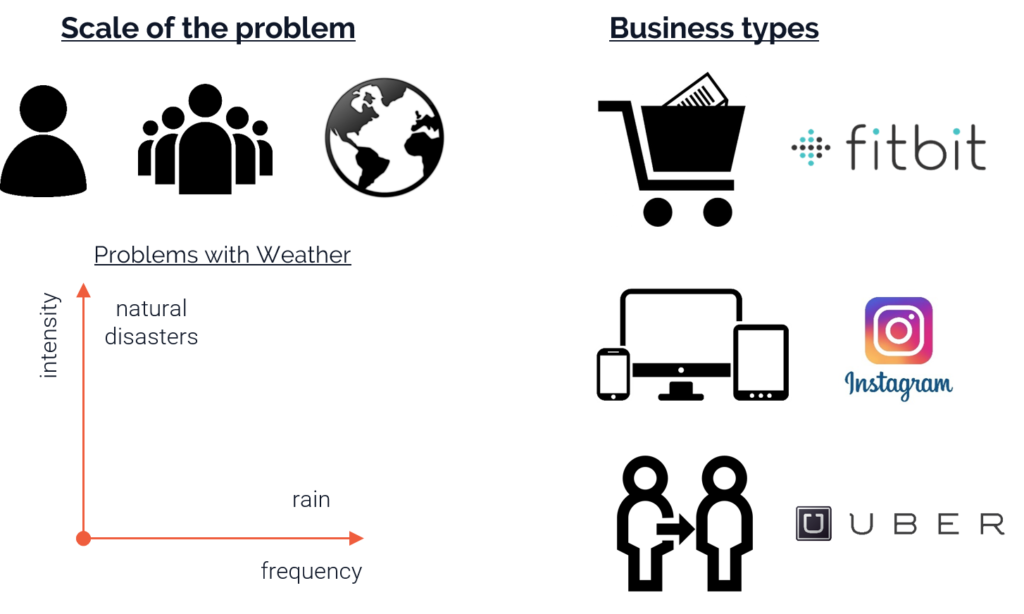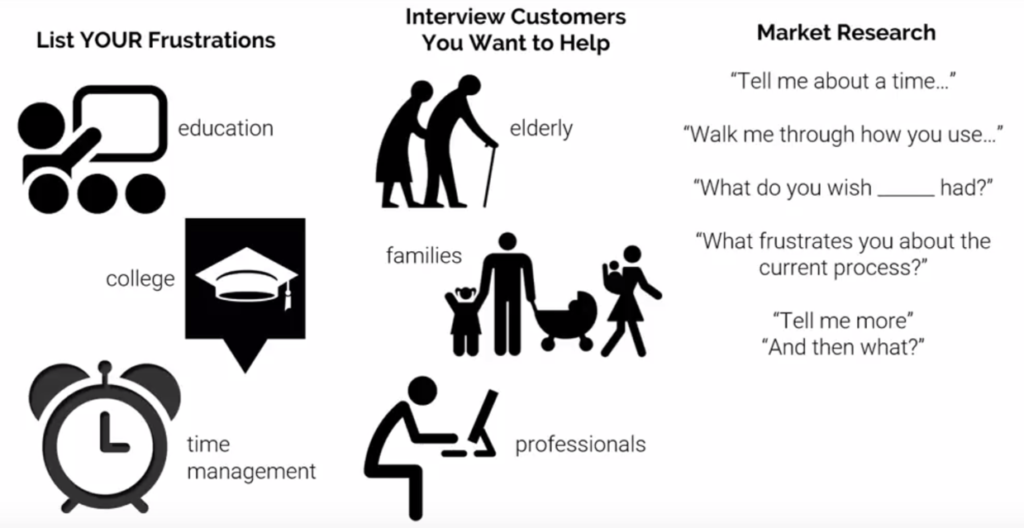Do you plan to start a career as an entrepreneur? Or do you want to know more about entrepreneurship activities?
One of the best platforms for MOOCs, edx.org, featured recently the course ‘Becoming an Entrepreneur‘. It has been designed by the MIT via its entrepreneurship program LaunchX. Here are some notes I wrote about it.
Main purpose of the course: Learn how to map your customer’s full use case — from when they discover they have a problem, through creating value, and getting word of mouth referrals from a satisfied customer.
A) Starting the journey
1) Entrepreneurship Recap
Entrepreneurship is the pursuit of opportunity beyond resources controlled:
- Pursuit: the actions of an individual entrepreneur — drive, resiliency, focus, discipline, and balance
- Opportunity: the type of venture — a better, cheaper, or more efficient offering for the customer
- Beyond resources controlled: managing the risks of external constraints
2) Goals as an Entrepreneur
Why do you want to be an entrepreneur?
What does being an entrepreneur mean to you?
How should a startup relate to the founders, customers, community, and society?
What defines good or worthwhile work?
What does money have to do with it?
What do experience, growth, and fulfillment have to do with it?
B) Ideation
1) Starting Methods
There are two main ways to start a company: based on a technology or based on customer needs.
Technology-driven entrepreneurship takes a new innovation and finds an application. Such as taking a passion for drones and using them to survey farmland to increase yields and reduce crop damage.
Customer-driven entrepreneurship refers to when an offering is developed for a specific customer problem. This is especially successful when there are already users cobbling together a solution.
An example is 99designs, addressing the need for new businesses to get design work at a reasonable rate and the need for amateur designers to build a portfolio, providing the opportunity for businesses to post design briefs and get lots of potential designs.
2) Considerations
Consider also the scale of the business you would like to start, and the type of business that interests you. All have their pros and cons.
Scale of the Problem
Problems may range from those that:
- You experience in your daily life
- Community impacting problems
- Global problems
Consider also looking at both high-intensity problems and frequent problems.
Business Types
- Products: tend to need to be prototyping to prove viability.
- Software Solutions: tend to need to be prototyped to prove scalability.
- Services: require many pilots to determine what drives customer satisfaction.
All of these require proving the customer need.
3) Choosing Your Interest Area
Choose an industry of interest to you, for example:
- Energy / sustainability
- Education
- Mobile / technology
- Lifestyle / consumer
- Health and wellness
Craft some problem statements, starting with “how might we”. Every word within the initial part of this prompt is powerful in helping setup a problem to be solved for the purposes of a potential startup.
Problem solving with words like “can” or “should” (how can we, how should we), start to imply judgment, which shuts down options instead of opening them up. Similarly, “how” keeps things open instead of a more closed question like “what”.
Finally, “we” sends a powerful message within the brainstorming session that there is no ownership of ideas – all ideas are meant to be built on, adapted, and collaborated on together.
Some example problem statements within education might be:
- How might we make high school classroom materials more engaging?
- How might we allow education to cater to different learning styles?
- How might we bring students together around interests instead of geography?
When developing your problem statements within your interest area, be careful to ensure that this problem statement is not too specific or too vague.
– Too specific is when it is crafted in a way that assumes a specific solution, such as “how might we use iPads to bring education to students in remote locations?”
=> Instead, this could be phrased as “how might we bring education to students in remote locations?” allowing multiple potential solutions.
– Similarly, the statement should not start too vague. A problem statement like “how might we make education more effective?” allows too much variation of interpretation, and therefore potential solutions.
=> It has hardly narrowed the prompt down from “education” in any way, so is not a compelling prompt.
You might also consider researching some trends more generally and within the industry for potentially compelling problems to solve.
4) Finding Opportunities
Look for ways that current customers of the market aren’t fully satisfied with the solutions available, plus look for potential customers who do not have access or skills for current offerings.
- Listen to your customers — Determine ideal customers in the segment and interview them about their needs and frustrations. Be sure not to be leading — ask open ended questions.
- Watch your competitors — Look at both top companies and newly hyped companies in the industry and assess their strengths and weaknesses. Ask some passionate customers about ways that they wish the offerings served them better.
- Assess barriers to being a customer — Determine if there are certain skills, access, awareness, etc. that makes the offering accessible to these customers, but prevent it from being desirable or accessible to others.
- Determine what other customers would adopt — If offerings were easier to use, more accessible, or otherwise barriers lowered, what customers might you want to target. Examples might include:
- the elderly,
- third world countries,
- less technologically advanced people,
- etc.
5) Start with a Problem Statement
How will you solve your problem statement? Here are some potential prompts to help you come up with ideas:
Who are the customers of the problem?
Is there a different end user than paying customer?
What would make them willing to pay more than they are now for a solution?
Where is the frustration the largest?
Where is the frustration most frequent?
What skills do I have that would give me an advantage in solving this?
Write down as many ideas that come to mind, without spending much time on any of them. The goal here is quantity!
6) Filtering Ideas – Recap
Our tool for filtering is to check the items roughly against “fit” and “potential”.
Fit — be a founding team that others believe in.
Roughly assess each idea from 1-10, using the following questions:
- How passionate are you about this idea?
- How enthusiastic are you to solve this problem?
- Does this idea play to your strengths?
Potential — give confidence that you would be creating value that you can capture.
Roughly assess each idea from 1-10, using the following questions:
- Is it a mission / north star vision (versus just a product idea / set of features)
- Would you be solving a real need?
- Are there enough people with this need who face it frequently enough to make it worth solving?
- Are customers willing to pay for a solution?
- Can you differentiate yourself against competitors?
- How scalable is this idea?
Determine which ideas score high on both dimensions. Narrow to a few ideas through this process, then review these a bit further. Do some research, plus get some outside input. If you find yourself leaning towards one even if it not being the highest ranked, that’s fine! Trust your gut over the numbers — this was just a helpful first pass to narrow the list.
7) Quiz Ideation
Question 1: How might you identify potential ideas?
a) Customer Problems
b) Ah-ha Moments
c) Think Outside the Box
Correct answer:Customer Problems. Identifying Needs of the customer and Gaps between potential customers and offerings are the two ways to identify ideas.
Question 2: Which is the correct order of doing structured brainstorming?
a) Put yourself in situations that inspire brainstorming like taking a shower
b) Look at cool new startups in the market, think about where else the market is going, and choose the coolest idea
c) Identify your interest areas, explore opportunities of the market, and optimize options for fit and potential correct
d) Make a list of your strengths, identify markets that are growing, and develop ideas that are at the intersection
Correct answer:Identify your interest areas, explore opportunities of the market, and optimize options for fit and potential correct
Keep reading other notes in the Online course ‘Becoming an Entrepreneur’ – part 2.


One thought on “Online course ‘Becoming an Entrepreneur’ – part 1”